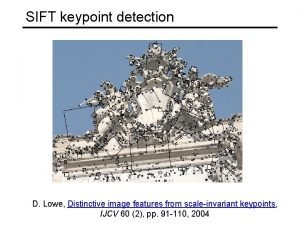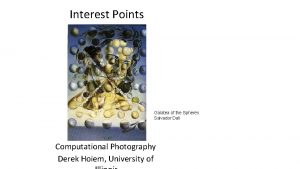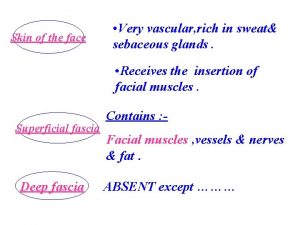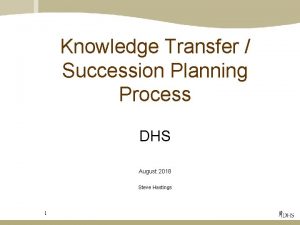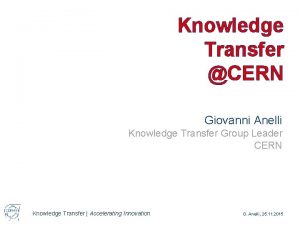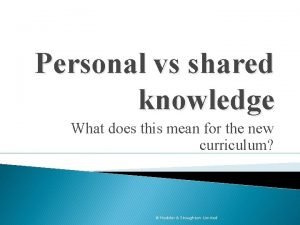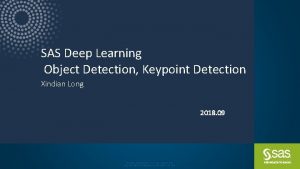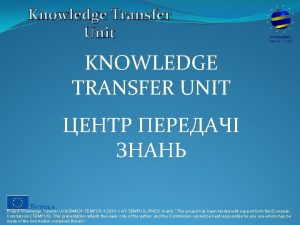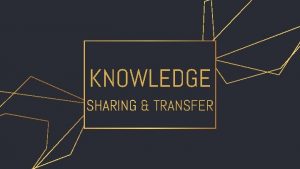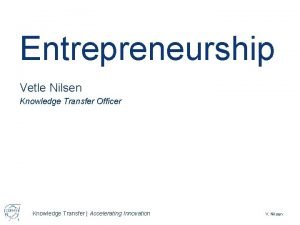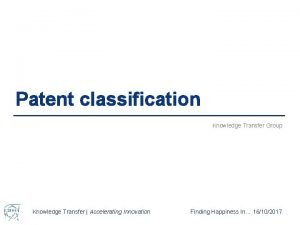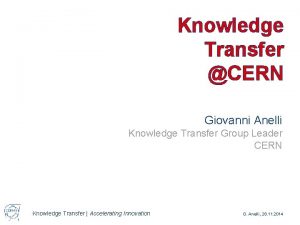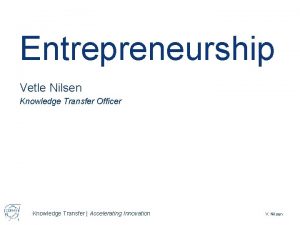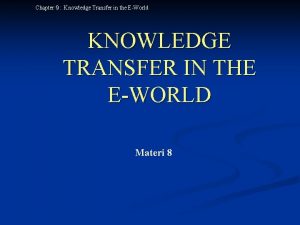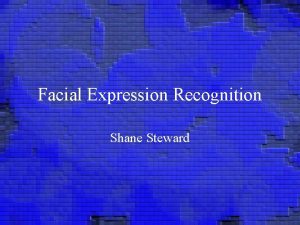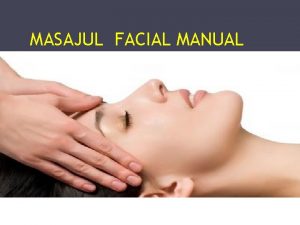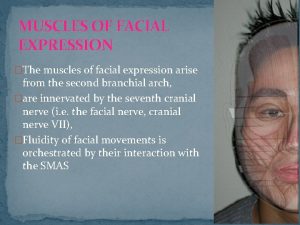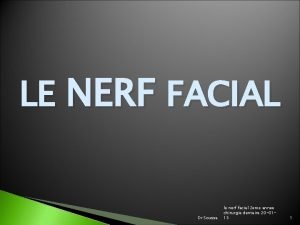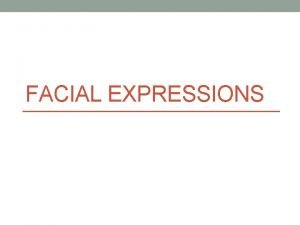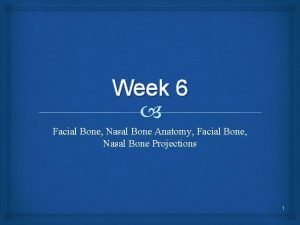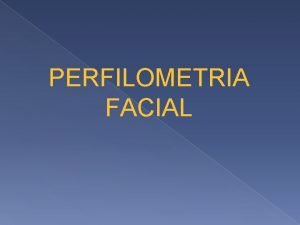Interspecies Knowledge Transfer for Facial Keypoint Detection Maheen













![Keypoint Detection Network • Variation of Vanilla CNN network from [1] • Pretrained with Keypoint Detection Network • Variation of Vanilla CNN network from [1] • Pretrained with](https://slidetodoc.com/presentation_image_h2/82f296e838a46e5b57d0bea259bfae95/image-14.jpg)





![Results - Comparison with TIF • Triplet Interpolated Features [1] developed for facial keypoint Results - Comparison with TIF • Triplet Interpolated Features [1] developed for facial keypoint](https://slidetodoc.com/presentation_image_h2/82f296e838a46e5b57d0bea259bfae95/image-20.jpg)






- Slides: 26

Interspecies Knowledge Transfer for Facial Keypoint Detection Maheen Rashid, Xiuye Gu, Yong Jae Lee CVPR 2017 UC Davis

The Problem Input Output

Outline • Pain Detection in Animals and Humans • Interspecies Transfer Learning for Keypoint Detection • Results and Discussion

Motivation • Facial expressions are a good indicator of pain. • Veterinary research has found expressions of pain for horses, sheep, and cows. Figure from [1]K. B. Gleerup, B. Forkman, C. Lindegaard, and P. H. Andersen. An equine pain face. Veterinary anesthesia and analgesia, 42(1): 103– 114, 2015 [2] K. M. Mc. Lennan, C. J. Rebelo, M. J. Corke, M. A. Holmes, M. C. Leach, and F. Constantino-Casas. Development of a facial expression scale using footrot and mastitis as models of pain in sheep. Applied Animal Behaviour Science , 176: 19– 26, 2016. [3]. B. Gleerup, P. H. Andersen, L. Munksgaard, and B. Forkman. Pain evaluation in dairy cattle. Applied Animal Behaviour Science, 171: 25– 32, 2015.

Motivation • Automatic detection of pain can have a big impact on animal welfare • • $0. 5 billion spent annually in the US to treat lameness in horses, and less acute levels are difficult to detect [1]. Human detection of animal pain is limited • Humans need to be trained to detect pain [2]. • Horses may hide expressions of pain near humans [3]. [1] Lameness and laminitis in U. S. horses. In USDA: APHIS: VS, National Animal Health Monitoring System. USDA, 2000. [2] K. B. Gleerup, B. Forkman, C. Lindegaard, and P. H. Andersen. Facial expressions as a tool for pain recognition in horses. In The 10 th International Equitation Science Conference, 2014. [3] Britt Alice Coles. "No pain, more gain? Evaluating pain alleviation post equine orthopedic surgery using subjective and objective measurements. " (2016).

Human Pain Detection • Automatic expression detection in humans is well explored • Computer vision system outperforms humans 85% accuracy to 55% on distinguishing fake and real pain [2] • Pain detection is at 91. 3% in [3] Figure from [1]G. Littlewort, J. Whitehill, T. Wu, I. Fasel, M. Frank, J. Movellan, and M. Bartlett. The computer expression recognition toolbox (cert). In Automatic Face & Gesture Recognition and Workshops (FG 2011), 2011 IEEE International Conference on, pages 298– 305. IEEE, 2011. [2]G. C. Littlewort, M. S. Bartlett, and K. Lee. Faces of pain: automated measurement of spontaneous facial expressions of genuine and posed pain. In Proceedings of the 9 th international conference on Multimodal interfaces, pages 15– 21. ACM, 2007. [3] P. Rodriguez, G. Cucurull, J. Gonzalez, J. M. Gonfaus, K. Nasrollahi, T. B. Moeslund, and F. X. Roca. Deep pain: Exploiting long short-term memory networks for facial expression classification. IEEE Transactions on Cybernetics, 2017

Animal Pain Detection • Predict three levels of pain. • Average accuracy of 64% [1] Y. Lu, M. Mahmoud, and P. Robinson. Estimating sheep pain level using facial action unit detection. In FG, 2017

Keypoint Detection • Keypoint detection on human faces is well explored • Typical CNN based approach: Figure from [1] Y. Wu and T. Hassner. Facial landmark detection with tweaked convolutional neural networks. ar. Xiv preprint ar. Xiv: 1511. 04031, 2015.

Keypoint Detection in Animals • Collecting large animal keypoint datasets is problematic. • Human keypoint datasets are large • Fine-tuning is a suboptimal solution Figure from [1] Y. Wu and T. Hassner. Facial landmark detection with tweaked convolutional neural networks. ar. Xiv preprint ar. Xiv: 1511. 04031, 2015.

Approach • Key Idea - Rather than bring the network closer to the data, bring the data closer to the network first • Warp animal faces to structurally look more human like before fine-tuning

Datasets • Created the Horse Facial Keypoint Dataset • • 3531 Training Images. 186 Testing Images Sheep Keypoint Dataset from [1] • Manually annotated 531 images with same set of keypoints • 432 Training Images. 99 Testing Images. [1] H. Yang, R. Zhang, and P. Robinson. Human and sheep facial landmarks localisation by triplet interpolated features. In WACV, 2016

Human-Animal Pairs • Used to train the warping network • Angular difference used for nearest pairing

Warping Network • Uses a Thin Plate Spline tranformer • Uses Euclidean loss for training
![Keypoint Detection Network Variation of Vanilla CNN network from 1 Pretrained with Keypoint Detection Network • Variation of Vanilla CNN network from [1] • Pretrained with](https://slidetodoc.com/presentation_image_h2/82f296e838a46e5b57d0bea259bfae95/image-14.jpg)
Keypoint Detection Network • Variation of Vanilla CNN network from [1] • Pretrained with human keypoint training images [1] Y. Wu and T. Hassner. Facial landmark detection with tweaked convolutional neural networks. ar. Xiv preprint ar. Xiv: 1511. 04031, 2015.

Putting it all together • Warping network is pretrained on animal-human pairs • Keypoint network is pretrained on human keypoints • Both losses are used during training

Baselines • Simple finetuning (BL Finetune) • Warping without human-animal pairs (BL TPS) • Scratch

Results - Qualitative

Results - Qualitative

Results - Error Rates • Failure is distance of >10% of head size Horse Dataset Sheep Dataset
![Results Comparison with TIF Triplet Interpolated Features 1 developed for facial keypoint Results - Comparison with TIF • Triplet Interpolated Features [1] developed for facial keypoint](https://slidetodoc.com/presentation_image_h2/82f296e838a46e5b57d0bea259bfae95/image-20.jpg)
Results - Comparison with TIF • Triplet Interpolated Features [1] developed for facial keypoint detection in sheep Horses Sheep [1] H. Yang, R. Zhang, and P. Robinson. Human and sheep facial landmarks localisation by triplet interpolated features. In WACV, 2016

• Results - Dataset Size 6. 72% point lower failure rate than the TPS baseline for 500 Images

Conclusion • Present a novel approach for transferring knowledge between loosely related data domains • Correct for shape difference between datasets

Questions


Enter Deep Networks • Deep Convolutional Neural Networks have shown impressive performance on a range of computer vision tasks • Close to human performance in Image. Net Challenge - 5. 1% (Human) vs. 6. 8% (Google. Net) [1] • State of the art in human key point detection is 4. 14% error rate [2] [1] http: //karpathy. github. io/2014/09/02/what-i-learned-from-competing-against-a-convnet-on-imagenet/ [2] S. Xiao, J. Feng, J. Xing, H. Lai, S. Yan, and A. Kassim. Robust facial landmark detection via recurrent attentive refinement networks. In ECCV, 2016.

Deep Convolutional Networks • Cascade of linear and non-linear processing units • Features are learned implicitly • Typically require large datasets for training Neural Net Figure from http: //cs 231 n. github. io/convolutional-networks/ Convolutional Neural Net
 Distinctive image features from scale invariant keypoints
Distinctive image features from scale invariant keypoints Keypoint matching
Keypoint matching Face veins and arteries
Face veins and arteries Transfer transfer
Transfer transfer Knowledge transfer matrix
Knowledge transfer matrix Torch of knowledge meaning
Torch of knowledge meaning Knowledge transfer office
Knowledge transfer office Knowledge transfer agreement
Knowledge transfer agreement Cern knowledge transfer
Cern knowledge transfer Cern knowledge transfer
Cern knowledge transfer Cern knowledge transfer
Cern knowledge transfer Transfer extranet
Transfer extranet Examples of posteriori knowledge
Examples of posteriori knowledge Knowledge shared is knowledge squared
Knowledge shared is knowledge squared Book smarts definition
Book smarts definition Knowledge creation and knowledge architecture
Knowledge creation and knowledge architecture Knowledge shared is knowledge multiplied interpretation
Knowledge shared is knowledge multiplied interpretation Knowledge and knower
Knowledge and knower Contoh shallow knowledge dan deep knowledge
Contoh shallow knowledge dan deep knowledge Gertler econ
Gertler econ Shared and personal knowledge
Shared and personal knowledge Redogör för vad psykologi är
Redogör för vad psykologi är Bra mat för unga idrottare
Bra mat för unga idrottare Ramsa geometriska former
Ramsa geometriska former Etik och ledarskap etisk kod för chefer
Etik och ledarskap etisk kod för chefer Publik sektor
Publik sektor Plagg i gamla rom
Plagg i gamla rom
